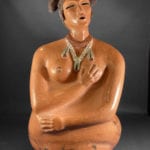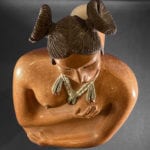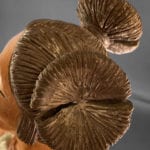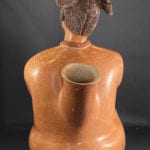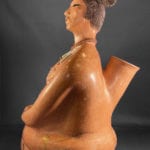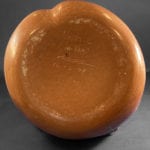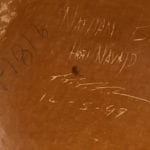The statue is 7.125″ deep (front to back) at the base; 6.125″ deep, chest to the lip of the spout.
This collection contains a number of Hopi effigy pots (see category listing), but nothing that approaches the form, detail or expressiveness of this work by Nathan Begaye. Nathan had a creative inquisitiveness that reminds me of Nampeyo, though their styles could not have been more different. Nampeyo experimented with designs from varied traditions: Kayenta black-on-white (2012-02), Acoma (2015-03) and Mexican Talavera (2019-19), among others. Nathan was inspired by his Hopi and Navajo heritage in forming his pots (cf 2019-24), but like Nampeyo , was willing to borrow from any tradition that caught his eye. For jar 2019-20 Nathan seems to have looked to prehistoric South America:
“Of all the ancient civilizations that flourished in the Americas, only one perfected true portraiture of living people and produced it in quantity—the Moche who inhabited the north coast of Peru between approximately AD 100 and 800. Using the medium of three-dimensional ceramic vessels…, Moche artisans typically formed the heads of the individuals they wished to portray, though sometimes they presented full figures with realistic portrait faces (Donnan, 2003:03).”
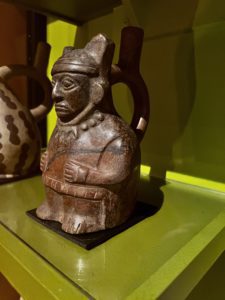
Much of the specific history of Moche portrait vessels is not similar to Nathan’s work. For example, all Moche portrait vessels depict males and most had stirrup spouts, though such vessels were also made as bowls, handled bottles and jars. Earlier vessels were probably hand-modeled, but the great flourishing of such portraiture was based on molds, a production process that Donnan details (2003: 9, 15, 21-41). However, the general form of jar 2019-20 seems derived from Moche portrait vessels, though there is no specific evidence that Nathan was aware of this tradition. At most he was inspired by this form but this jar was a product shaped by his unique imagination and skill.
I have no idea how Nathan formed pot 2019-20. Elves or an army of worker ants come to mind. The vessel is substantial, but not particularly heavy and therefore the walls must be fairly thin.. From the front, pot 2019-20 looks like a statue, but when seen from the side or back it is apparent that this is a vessel with a spout, like its Moche ancestors. The spout is sloped, its top edge about 1-inch long and the bottom edge about 4-inches long. The spount has a slight flair at its opening.
As far as I can see through the spout, the figure is hollow and my outstretched finger indicates that this is true into the upper torso. Given the jar’s relative lightness, I am guessing that many of the larger features were embossed. The two necklaces seem applied. As detailed below, there is some evidence that the head is solid. Whereas I have previously exclaimed over the detail and control of Nathan’s painting (see especially 2017-06 and 2018-10), my wonder here is about his ability to produce a maiden form of such detail, grace and character. The vessel is inscribed on the bottom with Nathan’s name, “Hopi Navajo,” his rain-cloud cypher, and a production date of 12-5-97.
The figure rises off a 3-inch base, which accounts for about 23% of the statue’s height. However, at the rear of this base, under the spout, the base is shaped into buttocks which disappear under the form. The base itself is not cylindrical, but is indented and slopes upward below the figure’s right arm with a similar but less dramatic indentation under her left arm. The base is creased at the maiden’s left front. Thus, what at first look appears like a simple base, reveals itself to be an abstracted depiction of crossed legs upon which the naked torso is sitting.
The skin of the figure is light brown, as befits its Native heritage. The left arm is bent, extends to her right (the viewer’s left), and rests with open fingers on the base, perhaps her right knee, though this is abstracted into the base. Her right arm is more sharply bent, with the hand modestly covering her left breast. Her right breast presents itself proudly, uncovered with a darker nipple and areola, ready to nurture a child when that time comes. Two necklaces encircle her neck. The smaller seems to be made of at least five strands of brown beads. The second is more vibrantly painted and clearly represent white shell heishi beads interspersed with turquoise beads. Over each breast a jacla of turquoise beads hangs from the heishi necklace, its end finished with brown shell pendants. An identical third jacla hangs between her breasts.
Rising above her long neck is a beautiful, animated face turned slightly to her left. The mouth is delicate and open, the lips so animated I can hear her chant during the quiet of a night. Her small nose is carefully delineated and bracketed by sculpted cheeks. In contrast to her realistic mouth and nose, her eyes are long dark slits, exactly like those found on depictions of the Polik’Mana. (See 2014-10 or 2017-03, for example.) The arching eyebrows are raised and realistic, as is her forehead. Thus all aspects of her face are delicate and realistic, except for those slit eyes. The eyes give her an unsettling gaze, as if she had insight into a different plane of time. The open mouth is about 0.5″ deep and thus casts its unpainted interior into a deep shadow. The slit eyes are cut to half that depth with their interior painted black, giving the impression of a deep gaze. Even the unpainted nostrils are delineated in detail, though a viewer would need to pick up the effigy and tilt it to see this. That the eyes, nostrils and mouth have a limited depth may indicate that the head is solid.
Traditionally, when a Hopi girl becomes a woman, she visits her grandmother’s (or great aunt’s) home and undergoes an initiation (“Ngumanvaki“) into her maturity. For four long days he demonstrates her domestic skills by hand grounding corn into fine flour. After initiation, her grandmother or great aunt combs the maiden’s long hair and then wraps it around a U-shaped wooden frame. The hair is tied off near the scalp, which makes the bundled hair stand out from the head. The hair is also tied between the two prongs of the wooden U, which is then removed. The end loops of bundled hair are then fanned out into the “squash blossom whorls” seen on Nathan’s maiden. A flap of shorter hair is left covering the ears, representing layers of rain clouds. Once this form was the everyday style of Hopi maidens. Now it mostly is worn during ceremonies, particularly the Niman dances in mid-summer after which the phalanx of kachinas bringing blessings to the mesas leave and return to their kiva in the San Francisco peaks.
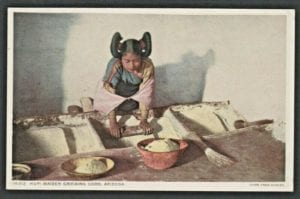
Hopi maiden grinding corn
This dramatic hair treatment intrigued outsiders who visited Hopi and became a recognized hallmark of Hopi culture. Nathan has taken great care with his maiden’s dark black hair. About 200 straight strands are cut into the clay with a part that runs from her forhead to the back of her neck. The requisite rectangular flap of hair covers each ear. Rising about 0.25 inches off her head, her hair whorls are about 1.875 inches in diameter and formed into two fans with wedge-shaped spaces between them. One whorl seems exactly parallel to the head, the second somewhat less so.
Aside from the skin tone, all of the color is displayed from the breasts upwards. Perhaps to draw a viewer’s eye along the full height of the vessel, Nathan has added flecks and splatters of gold paint on the circumference of the base below the arms, like the gold foil that devotees apply as offering to statues of the Buddha.
There are two feathers inside the jar, which I assume was inserted by Nathan. Feathers carry prayers for the Hopi and incorporating a feather into this pot gives the maiden spiritual energy as she sings her chant. I imagine her song a praise of the spirits that bring moisture.
Nathan may have made a number of variations of this maiden statue; I know of one other at the Boston Museum of Fine Arts (acession #2006.1911). See:
https://collections.mfa.org/objects/443106/squash-maiden-vessel
The museum figure is about 14-inches high and is dated on the bottom 12-19-2002, five years after the effigy in this collection. The Boston figure is naked and is shown without arms from the thighs upward. I find this form undignified. On the MFA, Boston effigy the ruffle around her neck is painted red and represents strands of coral beads. Perhaps Nathan had the same intention for the brown ruffle around the neck of 2019-20.
This collection includes two depictions by Nathan of the human body, a female maiden full of youth and promise and the slab-like, older male on a bowl made less than 10 years later (2015-02). The contrast saddens.


